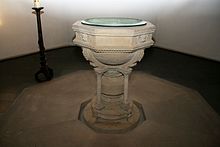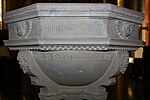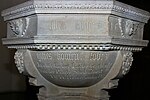Sendenhorster baptismal font from 1588
The Sendenhorster baptismal font from 1588 is a baptismal font that is located in the choir (east side) of the St. Laurentius Church in Westkirchen ( Ennigerloh ). It was made of Baumberger chalk lime and is incorporated into an octagon made of sandstone set into the floor . It is considered the oldest piece of equipment in the church and originally comes from Sendenhorst .
description
The foot, stand and pool together have a height of 1.28 meters, the pool width is 87 centimeters. The basin with inscriptions and coats of arms rests on four small columns. Small angel heads are attached to the angled holding arms of the pillars, and a putto is located above each angel's head between the cornices. The area between the cornices is wide, there are also strong profiles on the foot and stand, on the latter there are cylindrical knots with piqué patterns.
Inscriptions
In an essay from 1965, the historian and archivist Franz Flaskamp examined which Bible translation the inscription was based on. Accordingly, the text corresponds to the wording according to the version of the New Testament according to Hieronymus Emsers in the earliest post-Lutheran Catholic High German form from 1532. However, it cannot exactly interpret the dialectic character of individual words. He titled the year 1588 with the term " Deadline ID ", the inscription is made of " Gothic letters ".
| Inscriptions | ||||
| view | Transcription (Bible verses, coat of arms and dedication) | Bible verses according to Emser translation (1532) | Bible Verses according to Luther's Translation (1984) | |
|---|---|---|---|---|
| Lettering between the two upper cornices (all four side views combined) |
1588 * A gentleman a geloũe * a taũff, a godt * and * our vader all EPHE: 4 * including the coat of arms with the inscription HIERONIMVS HOGEHERTE |
A Lord / a Believe / a baptize God and Father of all of us | one Lord, one faith, one baptism; one God and Father of all ( Ephes 4,5-6 [1] ) | |
| Lettering basin (side view 1, coat of arms side) |
Then somebody was born | It is deñ / the yemand gebour | Unless someone is born | |
| Labeling basin (side view 2) |
get out of the water and become hillyẽ | be out of the water and holy | become of water and | |
| Labeling basin (side view 3) |
spirit, he can't get rich in dat | spirit, so he can't get into the realm | Spirit so he cannot enter the kingdom | |
| Inscription pool (side view 4, dedication side) |
gottes kōmen underneath is the dedication In Christian Love given by the parish Sendenhorst in 1871. Reinermann Rev. |
Gottis come | God come. ( Joh 3,5 LUT ) | |
Angel heads
Sendenhorster baptismal font - putto
Sendenhorster baptismal font - angel head
history
The founder Hieronimus Hogeherte
Flaskamp makes the case that the Sendenhorster baptismal font was donated by 1,588 from the Domküster Hieronimus Hogeherte. Hogeherte to this after the death of his first wife Anna Moller and in the initiation of marriage with his second wife Elisabeth Brüggemann his personal recommendation did. As possible candidates for the person of the founder Flaskamp draws first two people to consider: Hieronimus Hoyer, one mentioned in 1535 Munster shear citizens and 1553/54 pastor of Saerbeck, and his son Jerome Hogeherte, the Domküster. However, Flaskamp could only prove relationships with Sendenhorst for the son, especially since the Möllers and Brüggemann families had to be proven as part of the Sendenhorst citizenship.
Whereabouts of the baptismal font
The Sendenhorster baptismal font from 1588 originally belonged to the furnishings of the old Romanesque Sendenhorster church, a predecessor of St. Martin . The Romanesque church was badly damaged in a major fire in 1806, so that it was demolished decades later and the construction of a new church (St. Martin's Church) began in 1855. This was completed in 1865 and concluded with the consecration on November 14, 1865 by Bishop Johann Georg Müller . The baptismal font is one of the few pieces of equipment that was transferred to the new church.
In 1870, however, a neo-Gothic baptismal font with a translucent crystal was donated by a “local manor” for the new church. This foundation was probably the reason that Sendenhorst donated the old, here so called Sendenhorster baptismal font to the community of Westkirchen, as two baptismal fonts were not needed and one was dispensable. As the inscription shows, the parish of Sendenhorst was donated to the parish in Westkirchen in 1871 by a pastor named Reinermann. This can only mean Pastor Johann Reinermann from Emsdetten, who was pastor of the parish from 1865 to 1872. Since then the stone has been in the Laurentiuskirche.
At the end of 2015, there were plans in Sendenhorst to have a sculptor make a replica of the baptismal font as a baptismal font. This is to be set up as a display object in front of the church and serve as a station on the Martinsweg .
literature
- Franz Flaskamp : Jerome Hogeherte his Taufsteinstiftung for Sendenhorst . In: Westfalen 43, 1965, Vol. 3-4, pp. 220-222.
Web links
Individual evidence
- ↑ Josef Bernhard Nordhoff: The art and historical monuments of the Warendorf district , Münster: 1886, p. 131
- ↑ Franz Flaskamp : Jerome Hogeherte his Taufsteinstiftung Sendenhorst , page 220. In: Westphalia 43, 1965, Vol 3-4, pp 220-222.. With reference to: The whole New Testament, so translated by the highly acclaimed L (icentiatum) Hieronymum Emser . Posthumous edition, Tübingen 1532, pp. 65, 142.
- ↑ Franz Flaskamp : Jerome Hogeherte his Taufsteinstiftung Sendenhorst , page 220. In: Westphalia 43, 1965, Vol 3-4, pp 220-222..
- ↑ Hieronymus Emser: The whole new testament. … Auffs new with fleyß through // read and corrected by ... doctor Johan Dietenberger , Tübingen 1532, digitized version of the University and State Library Düsseldorf , 2011. p. 299 (CXLIIr).
- ↑ Hieronymus Emser: The whole new testament. … Auffs new with fleyß through // read and corrected by ... doctor Johan Dietenberger , Tübingen 1532, digitized version of the University and State Library Düsseldorf , 2011. p. 145 (LXVr).
- ↑ Franz Flaskamp : Jerome Hogeherte his Taufsteinstiftung for Sendenhorst . In: Westfalen 43, 1965, Vol. 3-4, pp. 220-222.
- ↑ Heinrich Petzmeyer: Sendenhorst. History of a small town in the Münsterland , Sendenhorst: 1993, p. 163.
- ↑ Franz Flaskamp : Jerome Hogeherte his Taufsteinstiftung Sendenhorst , page 220. In: Westphalia 43, 1965, Vol 3-4, pp 220-222..
- ↑ In the article in the Westfälische Nachrichten the year 1875 is incorrectly stated, but Flaskamp's information 1870, which refers to the relevant specialist literature, appears more reliable. Among other things, he consults the manual of the diocese of Münster from 1946, the Münsterland writer Ernst Raßmann and also Josef Bernhard Nordhoff. According to the newspaper article, the local estate mentioned by Flaskamp is a farmer named "Große Kogge", who donated the baptismal font out of gratitude because he had a son who was born to him to succeed him when he was old. See: Josef Thesing: At the fountain in front of the church , in: Westfälische Nachrichten, November 28, 2015
- ↑ In Westkirchen, too, the church had to be rebuilt after a village fire in 1868, so that there was a need for a baptismal font, see Flaskamp p. 220.
- ^ Pastor of Sendenhorst. In: Heimatverein Sendenhorst eV Retrieved on December 4, 2015 .
- ↑ a b Josef Thesing: At the fountain in front of the church , in: Westfälische Nachrichten , November 28, 2015








